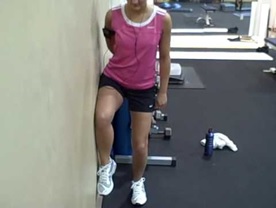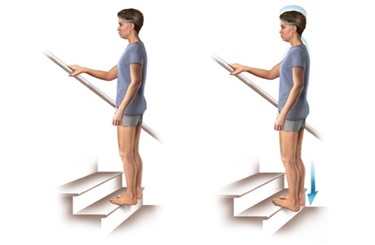Whether you are running your very first race or a seasoned runner gear up for a big race, spring is in the air, and it’s time we hit the roads or trails to prepare to meet our running and fitness goals.
Many local events, like Huntsville’s Band on the Run, have various options for the beginner to the seasoned runner. This can make 5km run/walk a realistic goal for many new runners.
However, it is estimated that as high as 80% of runners will end up with a running related injury at some point in their running career. Of that 80% majority of them are overuse or muscular imbalances. As a chiropractor who treats a large variety of sport related injuries, it is my job to educate patients on running injury prevention. So, wherever you are with your training or running career, there are some hard and fast rules to follow in an effort to prevent running injuries.
1. STRENGTH
Strength seems like a simple concept. The bottom line, if you develop a strong muscles, ligaments and tendons they can guard against many running injuries and improve running form. More often than not, we as therapists, see runners coming in with muscular imbalances. It may initially show up as back or hip pain, perhaps even knee, ankle or foot pain. Yes, other more serious structural injuries need to be ruled out, but typically it is due to a muscular imbalance. Typically what happens is repetitive use of the same muscles time and time again start to create tightness, weakness and imbalance. If the big stabilizers of the hip, pelvis (gluts) and core are weak and not functioning properly, other smaller muscles are called upon to do work they normally would not. Eventually these small muscles start complaining. How your knee turns in, your hip drops and your foot pronates with each step. This can remain consistent if things are strong, but if there is weakness, more stress is put on the muscles and the joints they attach to. Strength provides greater control and stability. This is particularly true because much of our running stride is carried out while standing on one leg or the other, not both.
Here are a few exercises to consider 2-3 times per week to build stabilizing muscles:
Wall Press
Why: activates gluteus medius
How: Stand with right side near a wall. Bend the right knee at 90 degrees and make contact with the wall. Push your knee into the wall and hold for 20-30sec. Do 2 sets of 3 on each side
Eccentric Heel Drop
Why: Strengthens the calves, ankle muscles and achilles to create stability when landing.
How: Stand with one leg on a step with your heel off of the edge. Lift up onto your toes, then slowly lower down until your heel is below the step. Start with 1 set of 10, build up to 3 sets of 15.
Stability Ball Bridge
hy: Strengthens the gluteus maximus and multifidus (small muscles in the back for spinal stability)
How: Lie on the ground with your feet on a stability ball, arms extended out or by your side. Lift your hips up off the floor so your body is in a straight line from knees to shoulders and hold. Try to hold for 60sec without the hips dropping. As you get stronger you can move the ball out toward the calves, then the heels for more of a challenge. Also, progress your arms from outstretched 90 degrees to your body to parallel beside your body, then lift them up 90 degrees straight into the air.
There are many more exercises to consider, but these are 3 to start with.
2. MOBILITY
Along with strength comes mobility. If muscles are overworked and they experience trauma, they will repair themselves, but are usually knotted together and limit our range of motion. Breaking down these adhesions allows the muscle to move more freely through its full range. It is best to do these after a run.
Hip Flexor Stretch
Why: tight hip flexors attach at the inside and front of the hip and into the low back. If they are tight, they can limit our back swing of our leg. Putting more stress on the leg joints.
How: in a lunge position, you can drop the back knee to the ground and keep the back upright tucking the tailbone under the pelvis and forward. That stretch should be felt in the front of the hip. Hold for (20-40 seconds).
Calf Foam Roll
Why: Knotted calf muscles are less effective shock absorbers
How: Sit on the floor and place a foam roller under the calf of an outstretched leg. Roll your calf over the roller, and if you find a painful spot, hang out there and press into the roller allowing it to ease (30-90sec).
3. Running Form
I will not get into running barefoot or minimalist etc. That is a discussion for another article. There are many differing opinions and variability in quality research. However, there is one common theme. Running with good posture and a proper stride can help reduce injuries.
Posture:
· upper torso upright, low back not arched (don’t allow your butt to stick out), head should be over shoulders
· swing the arms forward and back to maintain trunk stability, not across the body
· land lightly, it tends to shorten our stride and tends to allow us to land mid-foot, which lessens forces through our joints
· keep the body weight central and drive your hips forward, it keeps posture upright
· a faster cadence (number of steps per minute) can minimize forces on the joints by not over-striding
· when you land on your lead leg, your knee should be directly over your ankle
· engage your glutes, it can be as simple as tapping on your butt for a couple of seconds to keep the glutes active for stability
4. The 10% Rule:
Have you heard of the training rule of 10’s? The 10-percent rule is one of the most important and time-proven principles in running. It states that you should never increase your weekly mileage by more than 10 percent over the previous week.
The 10% Rule gains its importance from the fact that the vast majority of running injuries are overuse injuries. They occur when you run too much or increase your weekly training program too quickly. Say you’ve been running 15 km per week. For some reason—perhaps you want to prepare for an upcoming race or you just feel that you’re ready—you decide to pick up your training. Instead of running 5 km three times a week, you manage to fit in five 5-km’s. Your training increases from 15 km a week to 25 km a week—a 67 percent increase. Too much too soon.
This 10% rule also applies to speed work and intensity, including hills etc. as well as distance or time.
5. Shoes:
Again, another huge topic on its own. Basically go to a store that has options and someone who has some knowledge of shoe types and basic gait analysis. They should look at your old shoes, look at your type of foot and be able to offer you a few suggestions. Try on several pairs. The bottom line is you want a pair that offers you neutral pronation. What does that mean? Here’s how to figure it out: Rock side to side on your bare feet and feel the middle position. Then rock forward and backward to find the middle point. That is how your feet should feel when you are in your shoe. Neutral and comfortable. The foot should pronate, but not overly. If you feel you may have overly pronated feet or “flat feet”, you may require some support. However, there is no evidence custom orthotics are better than over-the-counter supports. If you have any questions, or are in pain, you will want to consult a therapist or health care professional who can properly assess your biomechanics and offer you some suggestions.
Also, changing footwear is extremely important. It is estimated that you should change your shoes every 400-600km. Even have a rotating pair of shoes. Or different types of shoes if you are varying your training. One for distance, one for speed work, one for trail runs. When you are starting out, one solid pair is enough. Be sure to keep track of the mileage you are putting on, it does add up quickly. One of the first signs footwear needs to be changed can be shin, or foot pain.
Running is a very enjoyable sport. It is generally quite affordable, compared to many other sports, and it is easy to take with you wherever you go. However, it can be quite demanding on your body. Walking and running is controlled falling. With each step we require the proper muscular control, stability and balance to keep us upright, and stop us from potentially injuring ourselves.
There are many learn to run programs offered through various gyms, and other groups across Muskoka. There is even a detailed running guide available, if you are to register for Band on the Run or join the MARS Running Club (Muskoka Algonquin Runners), compiled by our very own local Dr. Pierre Mikhail. Utilize these resources and join a like-minded group to help you reach your running goals…injury free.
If you have any questions regarding running injuries or proper training techniques you can feel free to contact me at Back in Balance Muskoka. I am a Chiropractor and Acupuncturist with a background in treating many sport related injuries.







